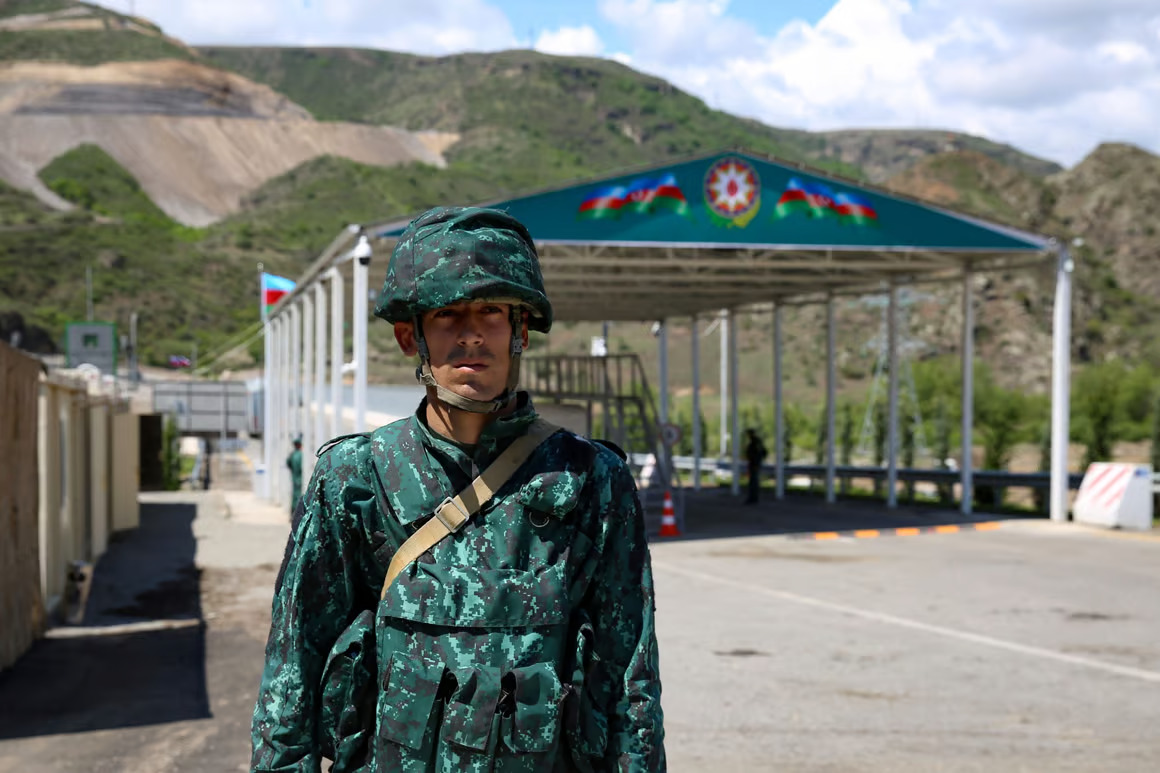Azerbaijan's border service announced that one of its guards was injured after he was shot by Armenian forces on Thursday, as tensions on the Armenia-Azerbaijan border escalated again.
The incident took place when the State Border Service of Azerbaijan was raising the state flag on the country’s sovereign territory in Lachin district.
The servicemen were targeted by the Armenian armed forces during the ceremony, resulting in injuries to Elshan Rustamov who was hospitalized.
The Azerbaijani side condemned the bloody event, calling it the next step by Armenia to derail the peace process. Azerbaijan’s Foreign Ministry called the incident an aggression against the country’s sovereignty and territorial integrity.
Following the attack, Baku stopped the operations at Lachin border checkpoint and the Prosecutor General’s Office launched an investigation into the incident, dispatching a group of investigators to the site.
“As the Office of the Prosecutor General, we declare that the incident site, located in the village of Gulyabird, Lachin district of the Republic of Azerbaijan, is the sovereign territory of the Republic of Azerbaijan without exception. The implementation of all necessary measures to identify and hold accountable the individuals responsible will be ensured,” the Prosecutor General’s Office said in a statement on Thursday.
Meanwhile, Yerevan said the Azerbaijani border troops were attempting to advance in Armenian territory – a claim denied by Azerbaijan.
Shortly after the attack in Lachin on June 15, the Armenian military launched an offensive towards Azerbaijan’s border district of Zangilan.
On June 16, Azerbaijani army positions in Gadabay border district were targeted again by Armenia’s military.
A significant portion of Azerbaijan’s state border with Armenia, measuring 1,007 kilometers in length, remained under Armenian occupation for nearly 30 years. The occupation began in the early 1990s when Azerbaijan’s Karabakh (Garabagh) and East Zangazur regions fell under illegal Armenian control.
Following the dissolution of the Soviet Union in 1991, Armenia launched a full-scale military campaign against Azerbaijan, resulting in the longest and deadliest war in the South Caucasus region. The war ended in a ceasefire in 1994, with Armenia forcibly occupying 20 percent of Azerbaijan’s internationally recognized territories. This occupation led to the deaths of over 30,000 Azerbaijanis and the expulsion of one million others in a brutal ethnic cleansing campaign conducted by Armenia.
On September 27, 2020, the conflict between Azerbaijan and Armenia escalated when Armenian forces in the occupied Azerbaijani lands shelled military positions and civilian settlements of Azerbaijan. In a counter-attack that lasted 44 days, Azerbaijani forces liberated over 300 settlements, including the cities of Jabrayil, Fuzuli, Zangilan, Gubadli, and Shusha, effectively ending the nearly 30-year-long illegal Armenian occupation. The war concluded with a tripartite statement signed by Armenia, Azerbaijan, and Russia on November 10, 2020. Under this statement, Armenia also returned the occupied districts of Aghdam, Kalbajar, and Lachin to Azerbaijan.
Following Azerbaijan’s victory in the 2020 war, cartographic complications emerged along the Armenia-Azerbaijan state border. Azerbaijan regained control over a significant portion of the border, leading to the deployment of units from the Armed Forces and State Border Service in border regions, including Kalbajar and Lachin, to strengthen border protection.
Since then, there have been frequent provocations against the Azerbaijani army by the Armenian military, including the latest bloody border incident, leading to significant complications on the frontier.
Baku has been urging for the immediate initiation of the delimitation and demarcation process to ease tensions with Yerevan. The process is based on five fundamental principles, proposed by the Azerbaijani government to Armenia in March 2022, aimed at normalization and the establishment of lasting peace.







 Azerbaijan is cementing its role as a critical energy partner for Europe, expanding the reach of its natural gas supplies and investing in European...
Azerbaijan is cementing its role as a critical energy partner for Europe, expanding the reach of its natural gas supplies and investing in European...
 Baku has rejected a call from French Foreign Minister Jean-Noël Barrot to release former leaders of the illegal Armenian armed separatist regime in...
Baku has rejected a call from French Foreign Minister Jean-Noël Barrot to release former leaders of the illegal Armenian armed separatist regime in...
 European Commission President Ursula von der Leyen has announced that the European Union (EU) has launched a package of $13.2 billion for the Centr...
European Commission President Ursula von der Leyen has announced that the European Union (EU) has launched a package of $13.2 billion for the Centr...
 Kazakh President Kassym-Jomart Tokayev and his visiting Slovenian counterpart, Natasa Pirc Musar, have discussed expanding cooperation in trade, in...
Kazakh President Kassym-Jomart Tokayev and his visiting Slovenian counterpart, Natasa Pirc Musar, have discussed expanding cooperation in trade, in...



